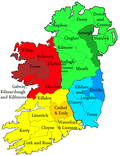This article includes a list of general references, but it lacks sufficient corresponding inline citations .(December 2022) |
Diocese of Clonfert Dioecesis Clonfertensis Deoise Chluain Fearta | |
|---|---|
 | |
| Location | |
| Country | Ireland |
| Territory | Parts of counties Galway, Offaly and Roscommon |
| Ecclesiastical province | Province of Tuam |
| Metropolitan | Archdiocese of Tuam |
| Statistics | |
| Area | 960 sq mi (2,500 km2) |
| Population |
|
| Information | |
| Denomination | Catholic Church |
| Sui iuris church | Latin Church |
| Rite | Roman rite |
| Established | Bishopric in 550; Diocese in 1111 |
| Cathedral | St. Brendan’s Cathedral, Loughrea |
| Patron saint | St Brendan |
| Current leadership | |
| Pope | Sede vacante |
| Bishop | Michael Duignan, Bishop of Clonfert |
| Metropolitan Archbishop | Francis Duffy, Archbishop of Tuam |
| Bishops emeritus | John Kirby |
| Map | |
 | |
| Website | |
| clonfertdiocese.ie | |
The Diocese of Clonfert (Irish : Deoise Chluain Fearta) is a Latin Church diocese of the Catholic Church [1] in the western part of Ireland. It is in the Metropolitan Province of Tuam.
Contents
- Territory
- History
- Early history
- Feudal period
- Catholic Emancipation
- Ordinaries
- See also
- References
- External links
Michael Duignan was appointed by the Holy See on 16 July 2019 and ordained bishop on 13 October 2019. [2] It is Ireland's smallest diocese by population and territory with a declining number of clergy and, in recognition of this, in Feb 2022 the Vatican united the diocese in persona episcopi with Michael Duignan serving simultaneously as Bishop of Clonfert and of Roman Catholic Diocese of Galway, Kilmacduagh and Kilfenora. [3]
